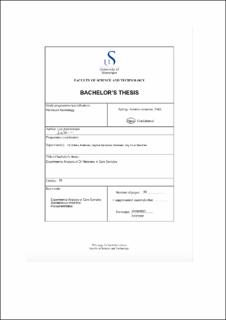| dc.contributor.advisor | Andersen, Pål Østebø | |
| dc.contributor.advisor | Standnes, Dag Chun | |
| dc.contributor.advisor | Sleveland, Dagfinn Søndenaa | |
| dc.contributor.author | Salomonsen, Liva | |
| dc.date.accessioned | 2021-09-07T16:31:38Z | |
| dc.date.available | 2021-09-07T16:31:38Z | |
| dc.date.issued | 2021 | |
| dc.identifier | no.uis:inspera:78834598:22977020 | |
| dc.identifier.uri | https://hdl.handle.net/11250/2774462 | |
| dc.description.abstract | An experimental analysis of oil recovery in core samples during spontaneous and forced imbibition have been performed. Grey Berea sandstone cores with a permeability around 120 mD have been used in the experiments. The cores were saturated 100 % with 1.0 M NaCl, before they were drained to approximately 10 %. They were then saturated with oil, either high viscous Marcol 82, or low-viscous n-Heptane. Six spontaneous imbibition experiments, and 5 forced imbibition experiments were performed. The forced imbibition experiments were performed with two different injection rates, 2 mL/h and 15 mL/h. The effects of viscosity and different injection rates on the oil recovery were studied. The results showed that the difference in viscosity did not have a big impact on the oil recovery for the spontaneous imbibition experiments. The limiting factor in the experiments turned out to be the low relative permeability of the brine, which resisted the effect of the viscosity ratio. In the forced imbibition experiments an unexpected trend was observed where both the water permeability and the residual oil saturation decreased by each experiment performed. | |
| dc.description.abstract | An experimental analysis of oil recovery in core samples during spontaneous and forced imbibition have been performed. Grey Berea sandstone cores with a permeability around 120 mD have been used in the experiments. The cores were saturated 100 % with 1.0 M NaCl, before they were drained to approximately 10 %. They were then saturated with oil, either high viscous Marcol 82, or low-viscous n-Heptane. Six spontaneous imbibition experiments, and 5 forced imbibition experiments were performed. The forced imbibition experiments were performed with two different injection rates, 2 mL/h and 15 mL/h. The effects of viscosity and different injection rates on the oil recovery were studied. The results showed that the difference in viscosity did not have a big impact on the oil recovery for the spontaneous imbibition experiments. The limiting factor in the experiments turned out to be the low relative permeability of the brine, which resisted the effect of the viscosity ratio. In the forced imbibition experiments an unexpected trend was observed where both the water permeability and the residual oil saturation decreased by each experiment performed. | |
| dc.language | eng | |
| dc.publisher | uis | |
| dc.title | Experimental Analysis of Oil Recovery in Core Samples | |
| dc.type | Bachelor thesis | |
